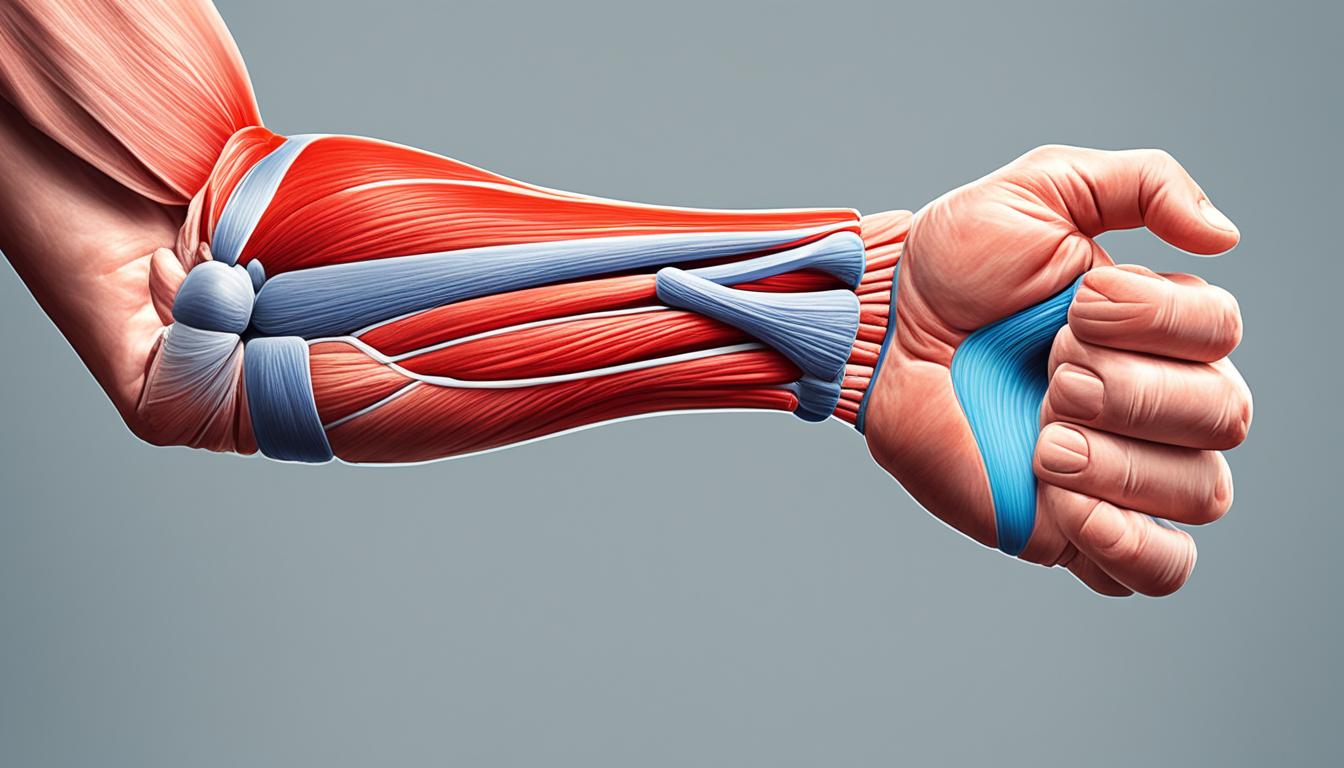Cramp muscle disease, or muscle cramps, is linked to graft-versus-host disease (GVHD). GVHD can happen after getting hematopoietic stem cell therapy. Muscle cramps are not clearly understood but are more common with chronic GVHD. They greatly affect daily life and how we feel.
People with this condition feel muscle cramps almost every day. They can last from 1 to 10 minutes and are very painful. These cramps can happen in areas beyond the calves. Some patients find it hard to treat them effectively. Muscle problems, nerve damage, and certain antibodies are linked to these cramps in GVHD.
Key Takeaways:
- Cramp muscle disease, or muscle cramps, is a condition associated with GVHD.
- Muscle cramps are more common in patients with chronic GVHD and can significantly impact daily activity and quality of life.
- Muscle cramps occur daily, last for 1 to 10 minutes, and are often accompanied by medium to severe pain intensity.
- Factors associated with muscle cramps in GVHD include myopathy, incipient demyelinating polyneuropathy, and the presence of antinuclear or antimitochondrial antibodies.
Symptoms of Cramp Muscle Disease
Cramp muscle disease, or muscle cramps, cause sudden and painful muscle contractions. They happen unexpectedly and can be stopped by gently stretching the tense muscle. The pain is intense, ranging from mild to severe, and it lasts from 1 to 10 minutes.
These cramps might make daily tasks hard and even disturb sleep. To help, you can do stretching exercises or use heat or cold on the sore muscle. Over-the-counter painkillers and staying hydrated can also lessen the pain.
Common Symptoms of Cramp Muscle Disease
- Painful muscle contractions: People with cramp muscle disease feel sudden and sharp muscle pains with no warning.
- Involuntary muscle movements: The muscle movements are not in your control and might make the muscle twitch or shake visibly.
- Localized or widespread: Cramps can happen in one muscle or many at the same time.
- Varying pain intensity: Pain levels from cramps can be different, from a little ache to a lot of pain.
- Duration: Normally, cramps last from 1 to 10 minutes but the time can change from person to person.
- Residual soreness: Some people might still have sore muscles after the cramp has gone away.
- Impact on daily life: Muscle cramps can make it tough to do daily things, move around, and sleep well.
Relieving Muscle Cramps
Treating the underlying problem helps relieve cramps and relax the muscle. To feel better, you can:
- Stretching exercises: Gently stretching the muscle can stop cramps during an episode.
- Heat or cold therapy: Using heat or ice on the muscle helps it relax and can lessen the cramp.
- Over-the-counter pain relievers: Medicines like NSAIDs can ease the pain and reduce any swelling with cramps.
- Hydration: Drinking enough water is key to avoid common triggers like dehydration that lead to cramps.
Always see a doctor for the right diagnosis and treatment plan. This way, you can manage cramp muscle disease well and enjoy a better life.
Causes and Diagnosis of Cramp Muscle Disease
Cramps, or muscle cramps, often happen after stem cell transplants in diseases like GVHD. Doctors are still figuring out what exactly causes these cramps. But, they know several factors play into it.
Contributing Factors to Muscle Cramp Development
In GVHD, issues like myopathy and certain antibodies can mess with muscle and nerve function. This leads to painful cramps. Knowing these factors helps in finding ways to prevent or treat cramps.
Preventing Muscle Cramps in GVHD
Managing the root condition of people with GVHD can help prevent cramps. This means using drugs to slow the body’s harmful reaction. Making specific lifestyle changes can also lower the risk of cramps.
Being well-hydrated is really important in staying cramp-free. Drink plenty of water around exercise. This keeps your muscles healthy. Also, stretching, like calf stretches, can stop cramps by making muscles less tight.
Diagnosing Cramp Muscle Disease
To diagnose cramp muscle disease, doctors look at a lot of things. They talk to the patient, do a physical check, and order tests. This is to be sure it’s not something else causing the cramps.
Tests check for muscle enzymes and autoimmune signs in the blood. A test called electromyography looks at muscle and nerve function. These tests help the doctor make the right treatment plan for the patient.
Stem Cell Therapy for Cramp Muscle Disease
Stem cell therapy is a new way to treat cramp muscle disease. This disease causes muscle cramps because of graft-versus-host disease (GVHD). This therapy works by injecting healthy stem cells into the patient’s body. The new cells aim to replace the damaged ones. This helps the immune system work better. It also helps the body fix tissues damaged by GVHD.
This treatment for muscle cramps is still being tested. Initial studies have shown some promise. But, we need more research to know for sure how well it works. For now, patients can also use other methods like physical therapy, pain management, and medicine to help with the cramps.
Healthcare workers are looking at stem cell therapy and other treatments. They want to help patients with cramp muscle disease. As they learn more and find better ways to treat it, they hope to offer more relief. The goal is to improve the lives of those affected.

